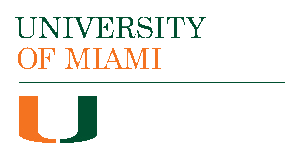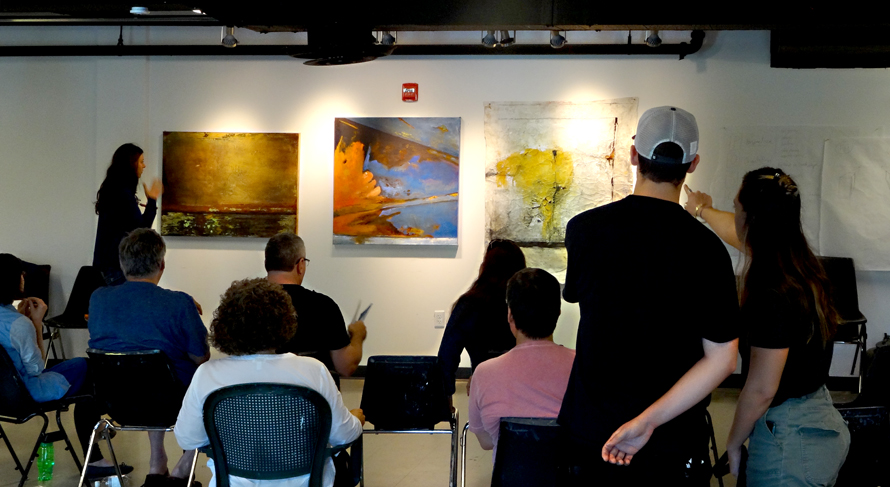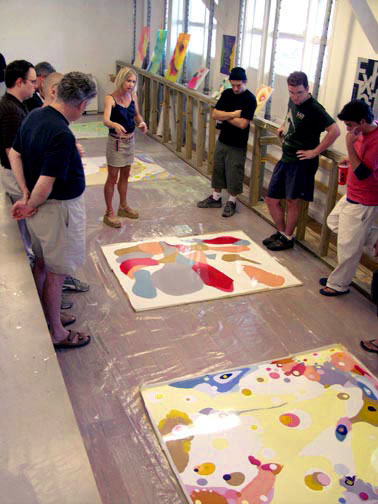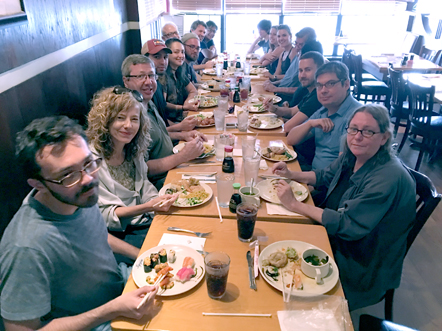

We are here for one reason and one reason only: to help you become the best painter you can be. Our instructors are exhibiting artists, each with a highly evolved individual specialty.
Brian Curtis is a representational painter who creates detailed figurative narratives in oil. Lise Drost is a printmaker who regularly combines drawing, painting, printing and collage when constructing her imagery. Amy Schissel creates drawings, paintngs, and installations that are inspired by digital modes of representing virtual spaces. Kyle Trowbridge's recent work involves housing digital coded messages within structured colorful geometric paintings. Gerardo Olhovich is a Modernist painter who improvises using abstracted landscape and/or figuration. The common denominator among these five instructors is their keen interest in the painting program and the quality of the work produced by the students in it.
Each of us has his/her own methods and styles but we all work together and share a common interest in the program and the advancement of our student’s abilities. Our program is structured to provide a high level of individualized attention.
BRIAN CURTIS
LISE DROST
AMY SCHISSEL
KYLE TROWBRIDGE
GERARDO OLHOVICH
In Memoriam
DARBY BANNARD 1934 - 2016

The small size of our painting program means that we are highly selective. Generally our top applicant(s) is offered a TA which carries with it a full tuition waiver and a $14,882 annual stipend. The TA is awarded for the entire three years - conditional upon good academic standing being maintained. Students receiving tuition waiver and annual stipend are required to contribute 15 hours per week in return to the operation of the department. Painting TAs frequently are assigned to help in the gallery, help with studio upkeep, assist the 2D tech, and in their second semester train for their three semester assignment as the teacher of record in Introduction to Perceptual Drawing (ART 101). TAs do contribute to a limited amount departmental upkeep in their last semester but not teach but instead concentrate on preparations for their solo thesis exhibition while putting finsihing touches on the written thesis document.
PROGRAM STRUCTURE
The University of Miami's MFA in Painting is a three year, 60 credit studio art degree. Our emphasis is on the production of quality paintings. Our program is deliberately kept small. We are recruiting for quality not quantity. There are appproximately twenty MFA graduate studio students across painting, ceramics, sculpture (glass), photo/digital, and printmaking in any given semester.
MFA degree requirements - a total of 60 credits are required for graduation (TAs take ten credits a semester in each of their six semesters).
• 24 Credits of Studio in Painting (minimum)
• 12 Credits of Electives (maybe in painting or other art courses but also may be taken in any discipline throughout the university in which the student is qualified to participate at the graduate level)
• 9 Credits of Art History at the graduate level
• 3 Credits Seminar in Contemporary American Art (ARH 698, taught by Art History faculty)
• 3 Credits Seminar in Studio Art (ART 604, taught by studio faculty)
• 3 Credits Exhibition and Document Preparation ( ART 699 seminar in the first semester of your third year)
• 6 Credits Master's Thesis (ART 710, intensive studio concentration in your last semester as you prepare your thesis exhibition)
Graduate Painting students are assigned a private studio with twelve month, 24/7 access for the duration of their participation in our program. Computer labs, large format ink-jet printers, the printmaking studio, the ceramic studios, and the wood, metalshop, and glass are all located near the painting studios.
Upon entry into the program, new graduate students are assigned a Supervisory Committee of three full-time faculty members who will meet with them at least twice a semester, until candidacy is awarded. Students can apply for candidacy only after they have completed 30 credits. Once candidacy is awarded, a Thesis Committee is seleced by the candidate in consultation with and approval by his/her committee chair. This Thesis Committee consists of four faculty members, one of whom should be from outside the department's studio faculty. The Thesis committee consults with and advises the student on his/her preparation for the thesis exhibition the candidate in preparing the written thesis document that accomplanies the thesis exhibition.
Each student's MFA thesis exhibition will be a solo show at the off-campus departmental gallery in the Wynwood Art Disctict, or at an alternative location arranged by the student approved by the Thesis Committee, such as an alternative art space or commercial gallery.
The Thesis Committee will also meet with the student at his/her thesis exhibition before it opens to the public, at which time the student will be asked to speak meaningfully about the work in the exhibition (thesis defense). Upon successful completion of the defense the student has their committee members sign approval forms for both their thesis document and their thesis defense. Both of these signed forms must be submitted to the Graduate Director, along with a copy of the written thesis docunment in both hard copy and digital versions.

